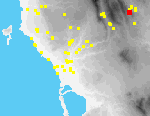 L03 Maryeli Ayios Ioannis
L03 Maryeli Ayios Ioannis
The site covers most of the summit of a small hill ca. 300 m. NW of Maryeli village. An overgrown bulldozer track spirals around the upper slopes of the hill, before reaching its summit. The top of the hill is planted with olives, but there are also many wild pear and oak trees; much of the surface is covered with straw and visibility is poor.
Almost all ceramic artifacts, including the HL-R bowl (see below), were found in a bulldozer cut near the summit of the hill.
Near the center of the summit there is an enigmatic stone-built structure: three upright limestone slabs (1.6 m. L. x 0.6 m. H.) and a taller, undecorated "headstone" (1.2 m. W. x 0.8 m. H. x 0.1 m. Th.) have been set on edge against each other to form an open rectangular "box".[093.32] At present the interior is filled with rubble and modern garbage.[112.13] Nearby to the SW, there is a neat pile of rubble and modern pottery (ca. 1.5 m. D. x 0.4 m. H.), cleared by farmers from fields on the summit.
Residents of Maryeli report that old graves with stone slab covers have been found on this hill, and there is a tradition that a church also stood there. It seems possible that stone slabs are the remains of a burial monument.
Other than a bowl rim (L94-244.1,2), only tile fragments were collected at this site.